Food Culture and Globalization
VerifiedAdded on 2020/04/21
|12
|2921
|73
AI Summary
This assignment delves into the complex relationship between food culture and globalization. It encourages students to analyze how global forces shape culinary traditions, consumer preferences, and the production of food. The assignment prompts exploration of topics like local food choices versus multinational fast-food chains, the impact of climate change on agriculture and food security, and the representation of diverse food cultures in media and tourism.
Contribute Materials
Your contribution can guide someone’s learning journey. Share your
documents today.
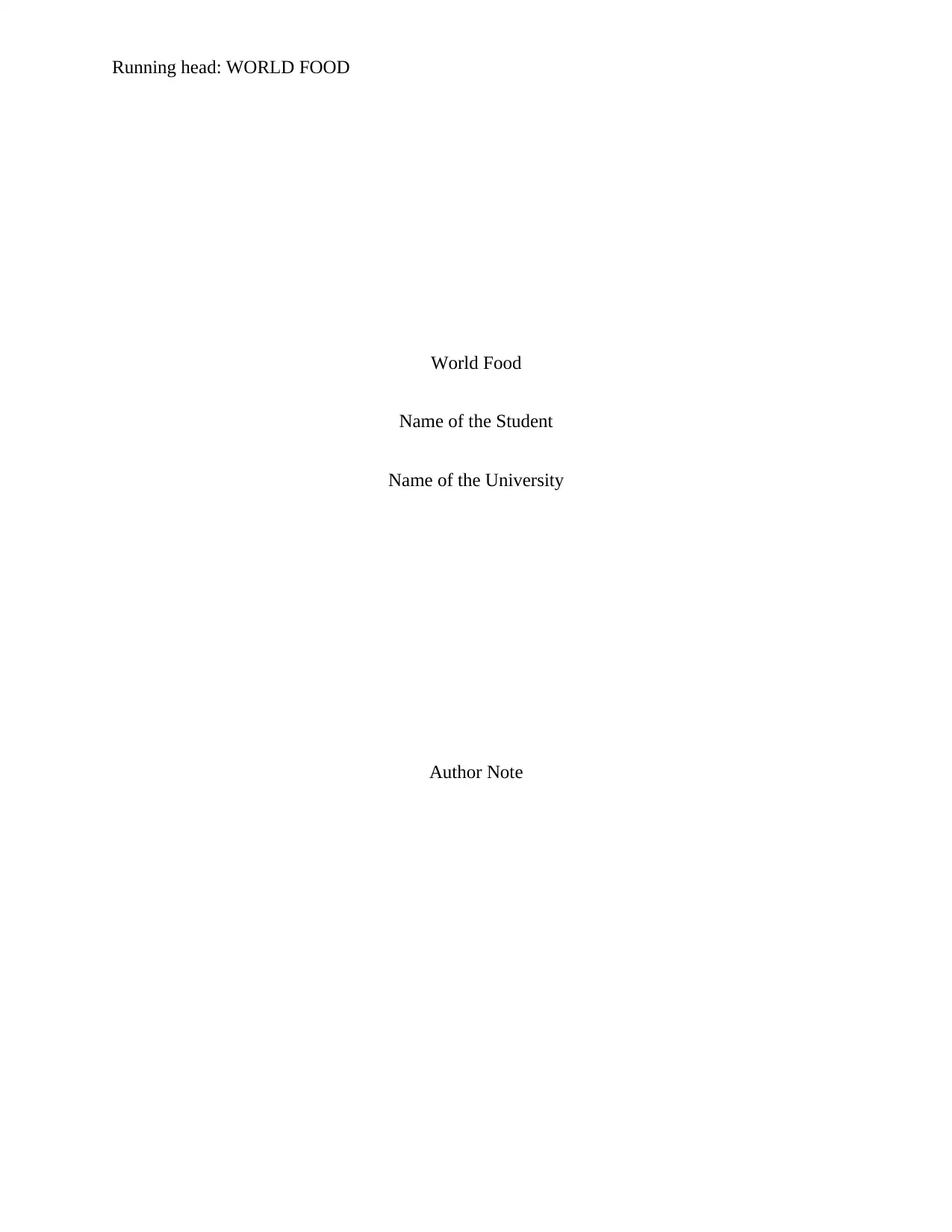
Running head: WORLD FOOD
World Food
Name of the Student
Name of the University
Author Note
World Food
Name of the Student
Name of the University
Author Note
Secure Best Marks with AI Grader
Need help grading? Try our AI Grader for instant feedback on your assignments.
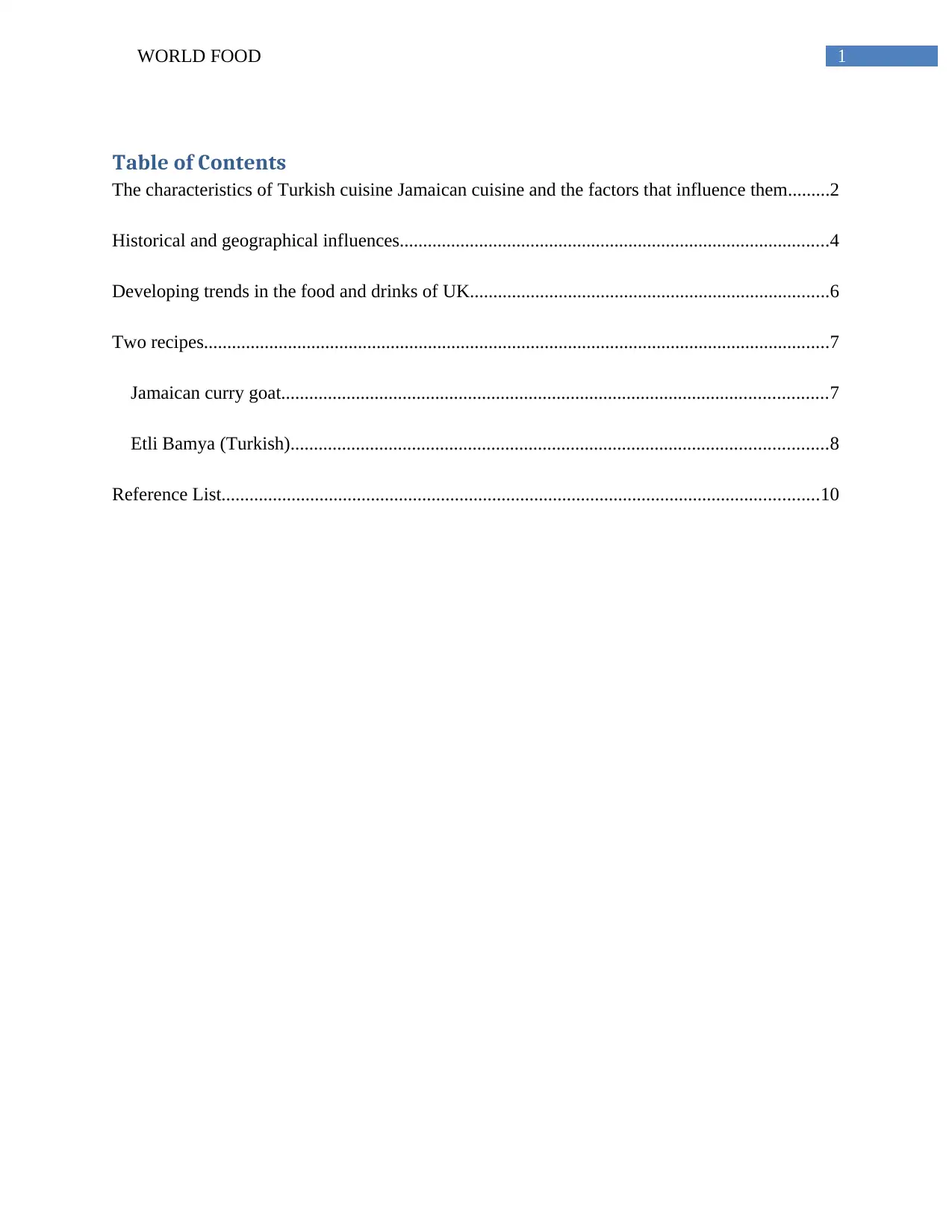
1WORLD FOOD
Table of Contents
The characteristics of Turkish cuisine Jamaican cuisine and the factors that influence them.........2
Historical and geographical influences............................................................................................4
Developing trends in the food and drinks of UK.............................................................................6
Two recipes......................................................................................................................................7
Jamaican curry goat.....................................................................................................................7
Etli Bamya (Turkish)...................................................................................................................8
Reference List................................................................................................................................10
Table of Contents
The characteristics of Turkish cuisine Jamaican cuisine and the factors that influence them.........2
Historical and geographical influences............................................................................................4
Developing trends in the food and drinks of UK.............................................................................6
Two recipes......................................................................................................................................7
Jamaican curry goat.....................................................................................................................7
Etli Bamya (Turkish)...................................................................................................................8
Reference List................................................................................................................................10
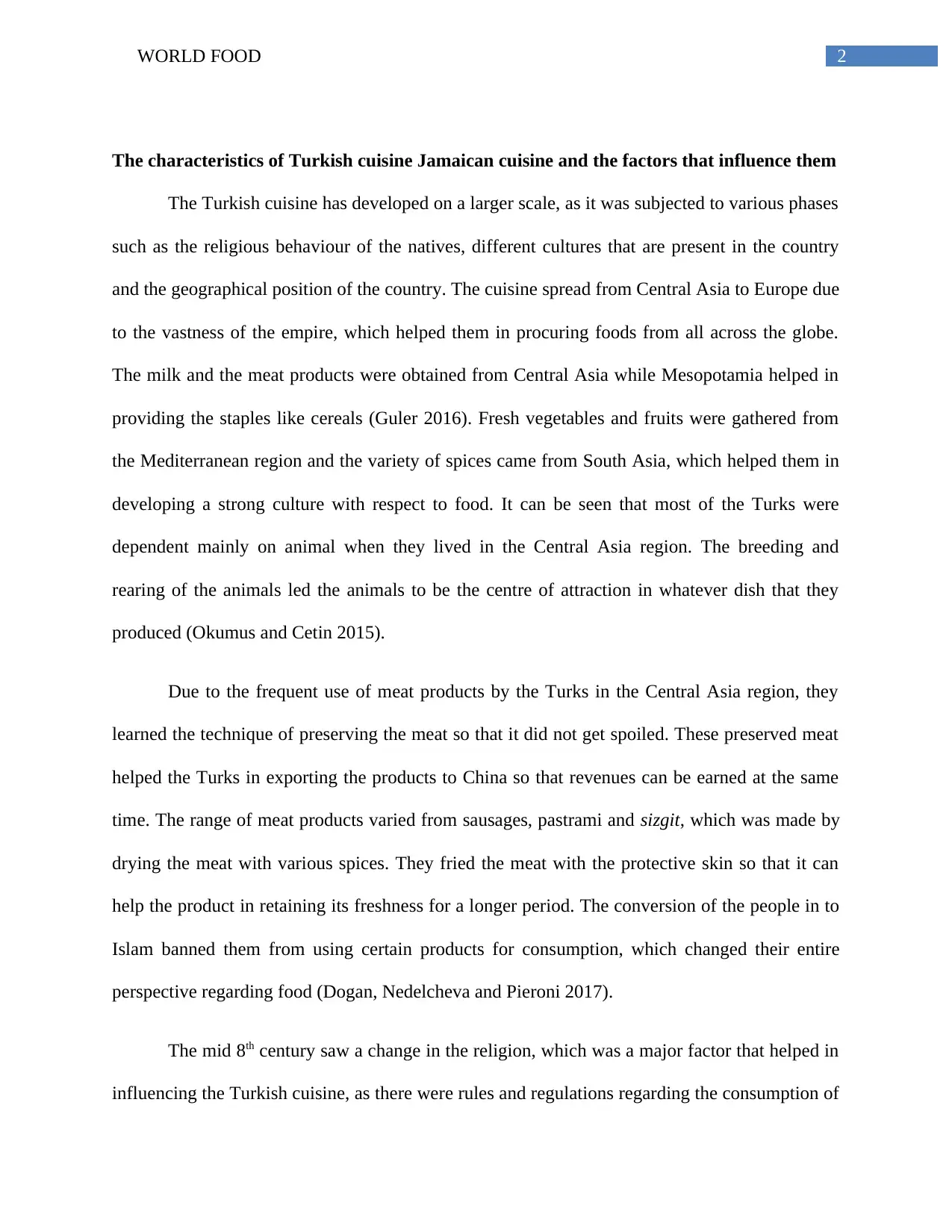
2WORLD FOOD
The characteristics of Turkish cuisine Jamaican cuisine and the factors that influence them
The Turkish cuisine has developed on a larger scale, as it was subjected to various phases
such as the religious behaviour of the natives, different cultures that are present in the country
and the geographical position of the country. The cuisine spread from Central Asia to Europe due
to the vastness of the empire, which helped them in procuring foods from all across the globe.
The milk and the meat products were obtained from Central Asia while Mesopotamia helped in
providing the staples like cereals (Guler 2016). Fresh vegetables and fruits were gathered from
the Mediterranean region and the variety of spices came from South Asia, which helped them in
developing a strong culture with respect to food. It can be seen that most of the Turks were
dependent mainly on animal when they lived in the Central Asia region. The breeding and
rearing of the animals led the animals to be the centre of attraction in whatever dish that they
produced (Okumus and Cetin 2015).
Due to the frequent use of meat products by the Turks in the Central Asia region, they
learned the technique of preserving the meat so that it did not get spoiled. These preserved meat
helped the Turks in exporting the products to China so that revenues can be earned at the same
time. The range of meat products varied from sausages, pastrami and sizgit, which was made by
drying the meat with various spices. They fried the meat with the protective skin so that it can
help the product in retaining its freshness for a longer period. The conversion of the people in to
Islam banned them from using certain products for consumption, which changed their entire
perspective regarding food (Dogan, Nedelcheva and Pieroni 2017).
The mid 8th century saw a change in the religion, which was a major factor that helped in
influencing the Turkish cuisine, as there were rules and regulations regarding the consumption of
The characteristics of Turkish cuisine Jamaican cuisine and the factors that influence them
The Turkish cuisine has developed on a larger scale, as it was subjected to various phases
such as the religious behaviour of the natives, different cultures that are present in the country
and the geographical position of the country. The cuisine spread from Central Asia to Europe due
to the vastness of the empire, which helped them in procuring foods from all across the globe.
The milk and the meat products were obtained from Central Asia while Mesopotamia helped in
providing the staples like cereals (Guler 2016). Fresh vegetables and fruits were gathered from
the Mediterranean region and the variety of spices came from South Asia, which helped them in
developing a strong culture with respect to food. It can be seen that most of the Turks were
dependent mainly on animal when they lived in the Central Asia region. The breeding and
rearing of the animals led the animals to be the centre of attraction in whatever dish that they
produced (Okumus and Cetin 2015).
Due to the frequent use of meat products by the Turks in the Central Asia region, they
learned the technique of preserving the meat so that it did not get spoiled. These preserved meat
helped the Turks in exporting the products to China so that revenues can be earned at the same
time. The range of meat products varied from sausages, pastrami and sizgit, which was made by
drying the meat with various spices. They fried the meat with the protective skin so that it can
help the product in retaining its freshness for a longer period. The conversion of the people in to
Islam banned them from using certain products for consumption, which changed their entire
perspective regarding food (Dogan, Nedelcheva and Pieroni 2017).
The mid 8th century saw a change in the religion, which was a major factor that helped in
influencing the Turkish cuisine, as there were rules and regulations regarding the consumption of
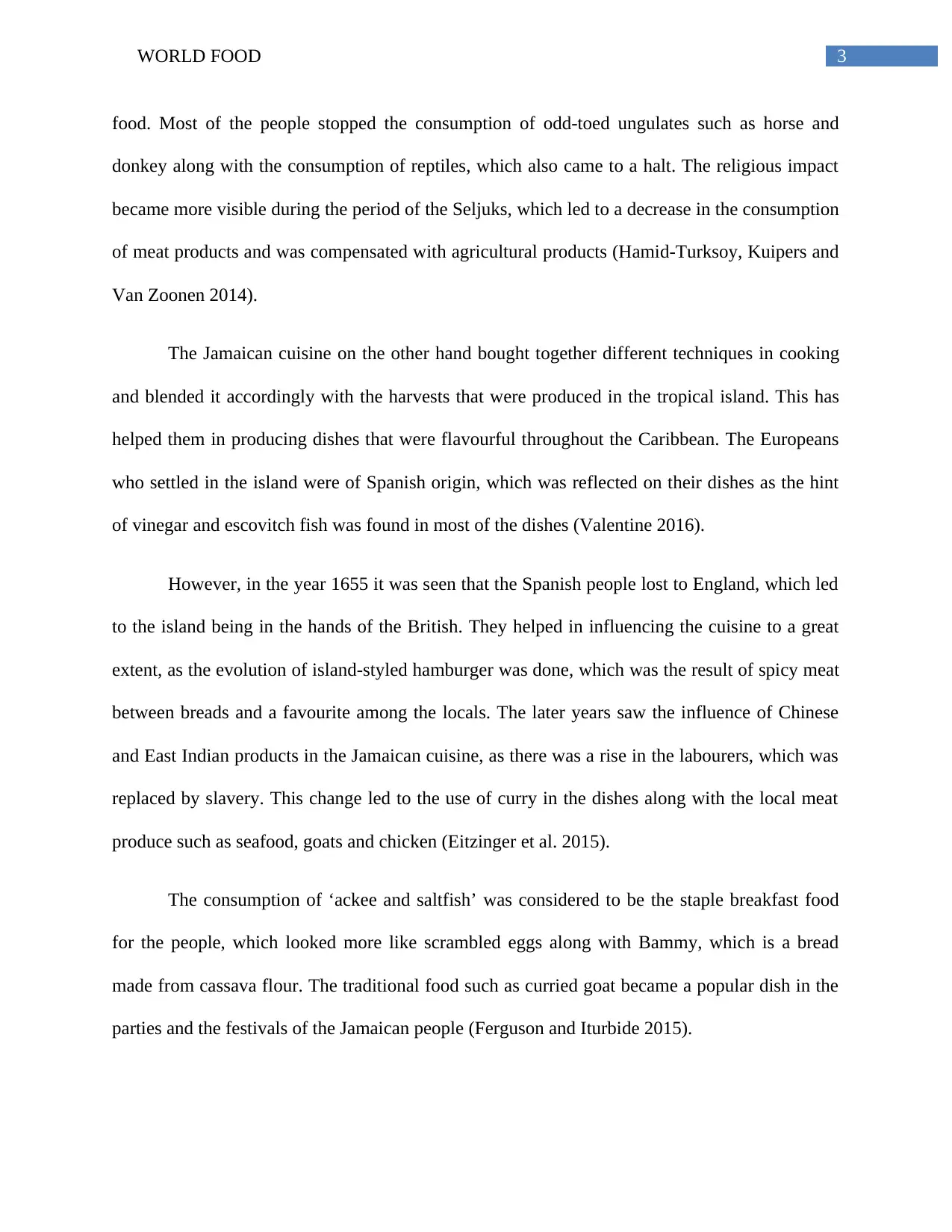
3WORLD FOOD
food. Most of the people stopped the consumption of odd-toed ungulates such as horse and
donkey along with the consumption of reptiles, which also came to a halt. The religious impact
became more visible during the period of the Seljuks, which led to a decrease in the consumption
of meat products and was compensated with agricultural products (Hamid-Turksoy, Kuipers and
Van Zoonen 2014).
The Jamaican cuisine on the other hand bought together different techniques in cooking
and blended it accordingly with the harvests that were produced in the tropical island. This has
helped them in producing dishes that were flavourful throughout the Caribbean. The Europeans
who settled in the island were of Spanish origin, which was reflected on their dishes as the hint
of vinegar and escovitch fish was found in most of the dishes (Valentine 2016).
However, in the year 1655 it was seen that the Spanish people lost to England, which led
to the island being in the hands of the British. They helped in influencing the cuisine to a great
extent, as the evolution of island-styled hamburger was done, which was the result of spicy meat
between breads and a favourite among the locals. The later years saw the influence of Chinese
and East Indian products in the Jamaican cuisine, as there was a rise in the labourers, which was
replaced by slavery. This change led to the use of curry in the dishes along with the local meat
produce such as seafood, goats and chicken (Eitzinger et al. 2015).
The consumption of ‘ackee and saltfish’ was considered to be the staple breakfast food
for the people, which looked more like scrambled eggs along with Bammy, which is a bread
made from cassava flour. The traditional food such as curried goat became a popular dish in the
parties and the festivals of the Jamaican people (Ferguson and Iturbide 2015).
food. Most of the people stopped the consumption of odd-toed ungulates such as horse and
donkey along with the consumption of reptiles, which also came to a halt. The religious impact
became more visible during the period of the Seljuks, which led to a decrease in the consumption
of meat products and was compensated with agricultural products (Hamid-Turksoy, Kuipers and
Van Zoonen 2014).
The Jamaican cuisine on the other hand bought together different techniques in cooking
and blended it accordingly with the harvests that were produced in the tropical island. This has
helped them in producing dishes that were flavourful throughout the Caribbean. The Europeans
who settled in the island were of Spanish origin, which was reflected on their dishes as the hint
of vinegar and escovitch fish was found in most of the dishes (Valentine 2016).
However, in the year 1655 it was seen that the Spanish people lost to England, which led
to the island being in the hands of the British. They helped in influencing the cuisine to a great
extent, as the evolution of island-styled hamburger was done, which was the result of spicy meat
between breads and a favourite among the locals. The later years saw the influence of Chinese
and East Indian products in the Jamaican cuisine, as there was a rise in the labourers, which was
replaced by slavery. This change led to the use of curry in the dishes along with the local meat
produce such as seafood, goats and chicken (Eitzinger et al. 2015).
The consumption of ‘ackee and saltfish’ was considered to be the staple breakfast food
for the people, which looked more like scrambled eggs along with Bammy, which is a bread
made from cassava flour. The traditional food such as curried goat became a popular dish in the
parties and the festivals of the Jamaican people (Ferguson and Iturbide 2015).
Secure Best Marks with AI Grader
Need help grading? Try our AI Grader for instant feedback on your assignments.
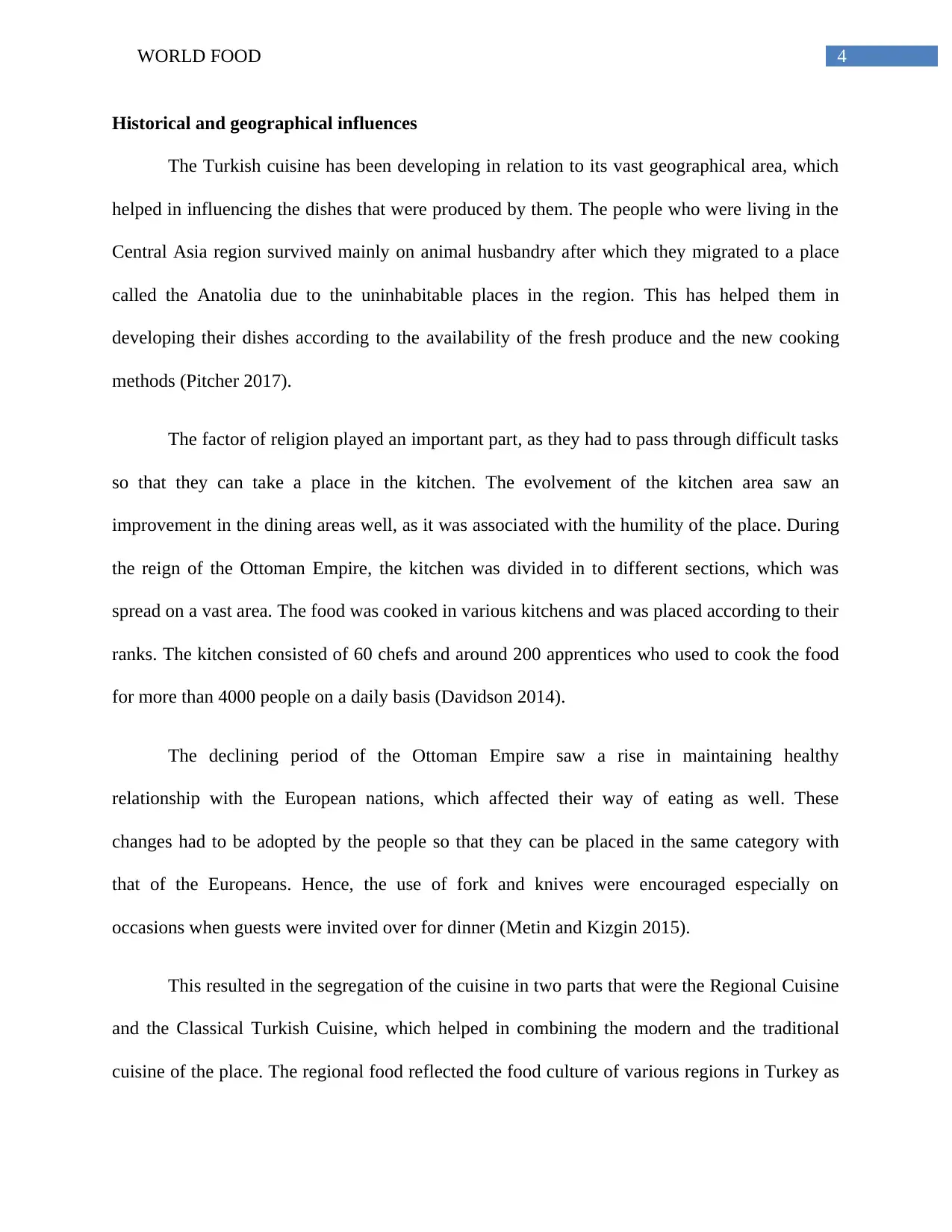
4WORLD FOOD
Historical and geographical influences
The Turkish cuisine has been developing in relation to its vast geographical area, which
helped in influencing the dishes that were produced by them. The people who were living in the
Central Asia region survived mainly on animal husbandry after which they migrated to a place
called the Anatolia due to the uninhabitable places in the region. This has helped them in
developing their dishes according to the availability of the fresh produce and the new cooking
methods (Pitcher 2017).
The factor of religion played an important part, as they had to pass through difficult tasks
so that they can take a place in the kitchen. The evolvement of the kitchen area saw an
improvement in the dining areas well, as it was associated with the humility of the place. During
the reign of the Ottoman Empire, the kitchen was divided in to different sections, which was
spread on a vast area. The food was cooked in various kitchens and was placed according to their
ranks. The kitchen consisted of 60 chefs and around 200 apprentices who used to cook the food
for more than 4000 people on a daily basis (Davidson 2014).
The declining period of the Ottoman Empire saw a rise in maintaining healthy
relationship with the European nations, which affected their way of eating as well. These
changes had to be adopted by the people so that they can be placed in the same category with
that of the Europeans. Hence, the use of fork and knives were encouraged especially on
occasions when guests were invited over for dinner (Metin and Kizgin 2015).
This resulted in the segregation of the cuisine in two parts that were the Regional Cuisine
and the Classical Turkish Cuisine, which helped in combining the modern and the traditional
cuisine of the place. The regional food reflected the food culture of various regions in Turkey as
Historical and geographical influences
The Turkish cuisine has been developing in relation to its vast geographical area, which
helped in influencing the dishes that were produced by them. The people who were living in the
Central Asia region survived mainly on animal husbandry after which they migrated to a place
called the Anatolia due to the uninhabitable places in the region. This has helped them in
developing their dishes according to the availability of the fresh produce and the new cooking
methods (Pitcher 2017).
The factor of religion played an important part, as they had to pass through difficult tasks
so that they can take a place in the kitchen. The evolvement of the kitchen area saw an
improvement in the dining areas well, as it was associated with the humility of the place. During
the reign of the Ottoman Empire, the kitchen was divided in to different sections, which was
spread on a vast area. The food was cooked in various kitchens and was placed according to their
ranks. The kitchen consisted of 60 chefs and around 200 apprentices who used to cook the food
for more than 4000 people on a daily basis (Davidson 2014).
The declining period of the Ottoman Empire saw a rise in maintaining healthy
relationship with the European nations, which affected their way of eating as well. These
changes had to be adopted by the people so that they can be placed in the same category with
that of the Europeans. Hence, the use of fork and knives were encouraged especially on
occasions when guests were invited over for dinner (Metin and Kizgin 2015).
This resulted in the segregation of the cuisine in two parts that were the Regional Cuisine
and the Classical Turkish Cuisine, which helped in combining the modern and the traditional
cuisine of the place. The regional food reflected the food culture of various regions in Turkey as
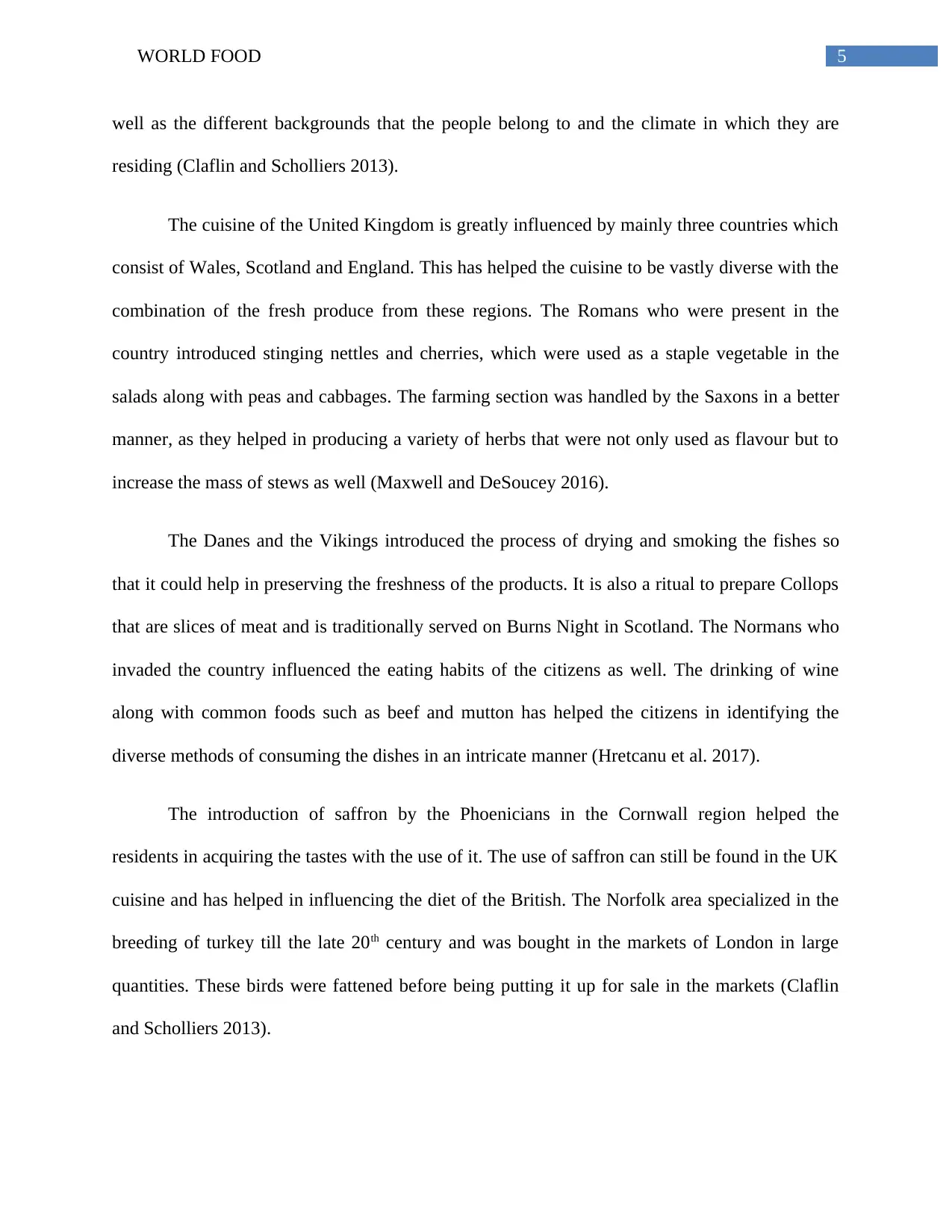
5WORLD FOOD
well as the different backgrounds that the people belong to and the climate in which they are
residing (Claflin and Scholliers 2013).
The cuisine of the United Kingdom is greatly influenced by mainly three countries which
consist of Wales, Scotland and England. This has helped the cuisine to be vastly diverse with the
combination of the fresh produce from these regions. The Romans who were present in the
country introduced stinging nettles and cherries, which were used as a staple vegetable in the
salads along with peas and cabbages. The farming section was handled by the Saxons in a better
manner, as they helped in producing a variety of herbs that were not only used as flavour but to
increase the mass of stews as well (Maxwell and DeSoucey 2016).
The Danes and the Vikings introduced the process of drying and smoking the fishes so
that it could help in preserving the freshness of the products. It is also a ritual to prepare Collops
that are slices of meat and is traditionally served on Burns Night in Scotland. The Normans who
invaded the country influenced the eating habits of the citizens as well. The drinking of wine
along with common foods such as beef and mutton has helped the citizens in identifying the
diverse methods of consuming the dishes in an intricate manner (Hretcanu et al. 2017).
The introduction of saffron by the Phoenicians in the Cornwall region helped the
residents in acquiring the tastes with the use of it. The use of saffron can still be found in the UK
cuisine and has helped in influencing the diet of the British. The Norfolk area specialized in the
breeding of turkey till the late 20th century and was bought in the markets of London in large
quantities. These birds were fattened before being putting it up for sale in the markets (Claflin
and Scholliers 2013).
well as the different backgrounds that the people belong to and the climate in which they are
residing (Claflin and Scholliers 2013).
The cuisine of the United Kingdom is greatly influenced by mainly three countries which
consist of Wales, Scotland and England. This has helped the cuisine to be vastly diverse with the
combination of the fresh produce from these regions. The Romans who were present in the
country introduced stinging nettles and cherries, which were used as a staple vegetable in the
salads along with peas and cabbages. The farming section was handled by the Saxons in a better
manner, as they helped in producing a variety of herbs that were not only used as flavour but to
increase the mass of stews as well (Maxwell and DeSoucey 2016).
The Danes and the Vikings introduced the process of drying and smoking the fishes so
that it could help in preserving the freshness of the products. It is also a ritual to prepare Collops
that are slices of meat and is traditionally served on Burns Night in Scotland. The Normans who
invaded the country influenced the eating habits of the citizens as well. The drinking of wine
along with common foods such as beef and mutton has helped the citizens in identifying the
diverse methods of consuming the dishes in an intricate manner (Hretcanu et al. 2017).
The introduction of saffron by the Phoenicians in the Cornwall region helped the
residents in acquiring the tastes with the use of it. The use of saffron can still be found in the UK
cuisine and has helped in influencing the diet of the British. The Norfolk area specialized in the
breeding of turkey till the late 20th century and was bought in the markets of London in large
quantities. These birds were fattened before being putting it up for sale in the markets (Claflin
and Scholliers 2013).
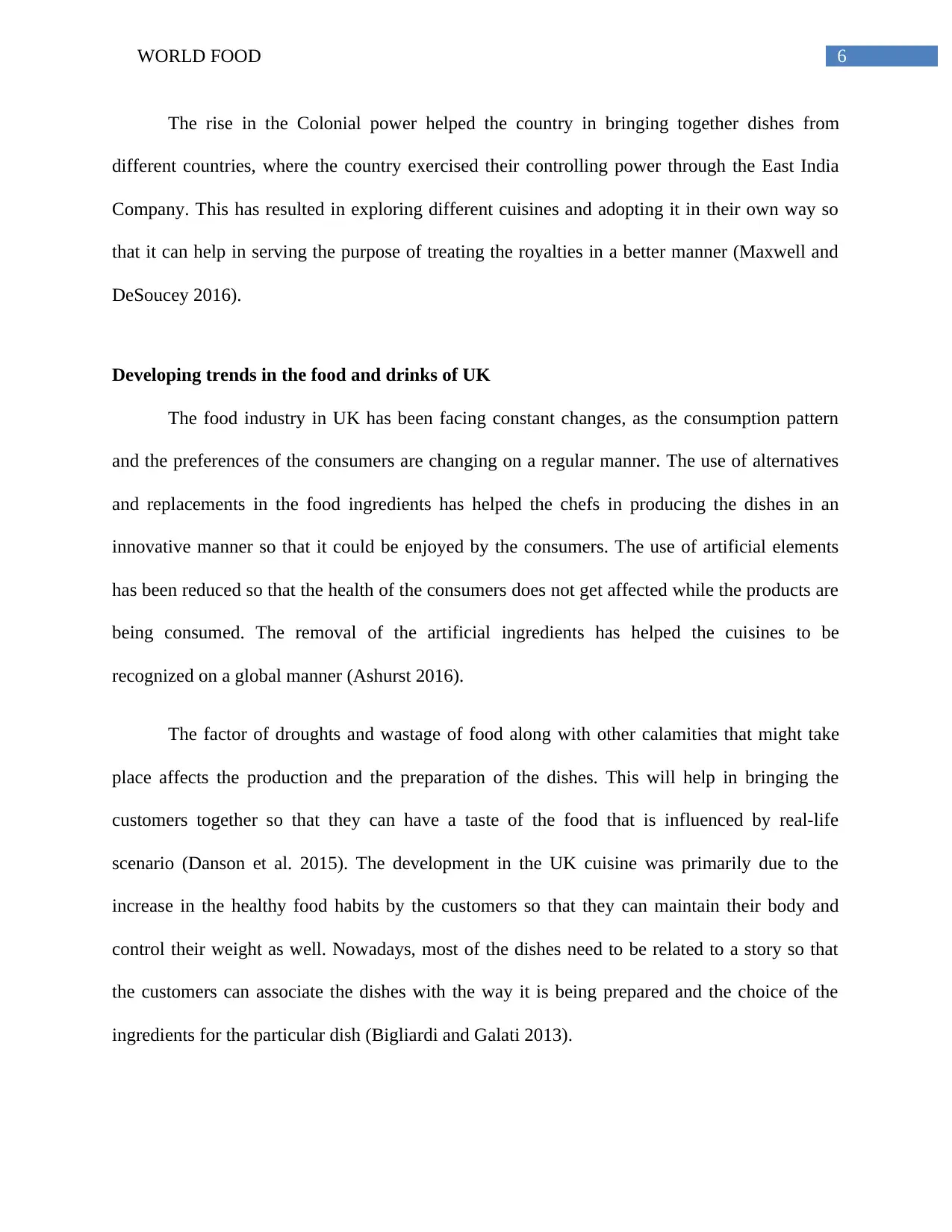
6WORLD FOOD
The rise in the Colonial power helped the country in bringing together dishes from
different countries, where the country exercised their controlling power through the East India
Company. This has resulted in exploring different cuisines and adopting it in their own way so
that it can help in serving the purpose of treating the royalties in a better manner (Maxwell and
DeSoucey 2016).
Developing trends in the food and drinks of UK
The food industry in UK has been facing constant changes, as the consumption pattern
and the preferences of the consumers are changing on a regular manner. The use of alternatives
and replacements in the food ingredients has helped the chefs in producing the dishes in an
innovative manner so that it could be enjoyed by the consumers. The use of artificial elements
has been reduced so that the health of the consumers does not get affected while the products are
being consumed. The removal of the artificial ingredients has helped the cuisines to be
recognized on a global manner (Ashurst 2016).
The factor of droughts and wastage of food along with other calamities that might take
place affects the production and the preparation of the dishes. This will help in bringing the
customers together so that they can have a taste of the food that is influenced by real-life
scenario (Danson et al. 2015). The development in the UK cuisine was primarily due to the
increase in the healthy food habits by the customers so that they can maintain their body and
control their weight as well. Nowadays, most of the dishes need to be related to a story so that
the customers can associate the dishes with the way it is being prepared and the choice of the
ingredients for the particular dish (Bigliardi and Galati 2013).
The rise in the Colonial power helped the country in bringing together dishes from
different countries, where the country exercised their controlling power through the East India
Company. This has resulted in exploring different cuisines and adopting it in their own way so
that it can help in serving the purpose of treating the royalties in a better manner (Maxwell and
DeSoucey 2016).
Developing trends in the food and drinks of UK
The food industry in UK has been facing constant changes, as the consumption pattern
and the preferences of the consumers are changing on a regular manner. The use of alternatives
and replacements in the food ingredients has helped the chefs in producing the dishes in an
innovative manner so that it could be enjoyed by the consumers. The use of artificial elements
has been reduced so that the health of the consumers does not get affected while the products are
being consumed. The removal of the artificial ingredients has helped the cuisines to be
recognized on a global manner (Ashurst 2016).
The factor of droughts and wastage of food along with other calamities that might take
place affects the production and the preparation of the dishes. This will help in bringing the
customers together so that they can have a taste of the food that is influenced by real-life
scenario (Danson et al. 2015). The development in the UK cuisine was primarily due to the
increase in the healthy food habits by the customers so that they can maintain their body and
control their weight as well. Nowadays, most of the dishes need to be related to a story so that
the customers can associate the dishes with the way it is being prepared and the choice of the
ingredients for the particular dish (Bigliardi and Galati 2013).
Paraphrase This Document
Need a fresh take? Get an instant paraphrase of this document with our AI Paraphraser
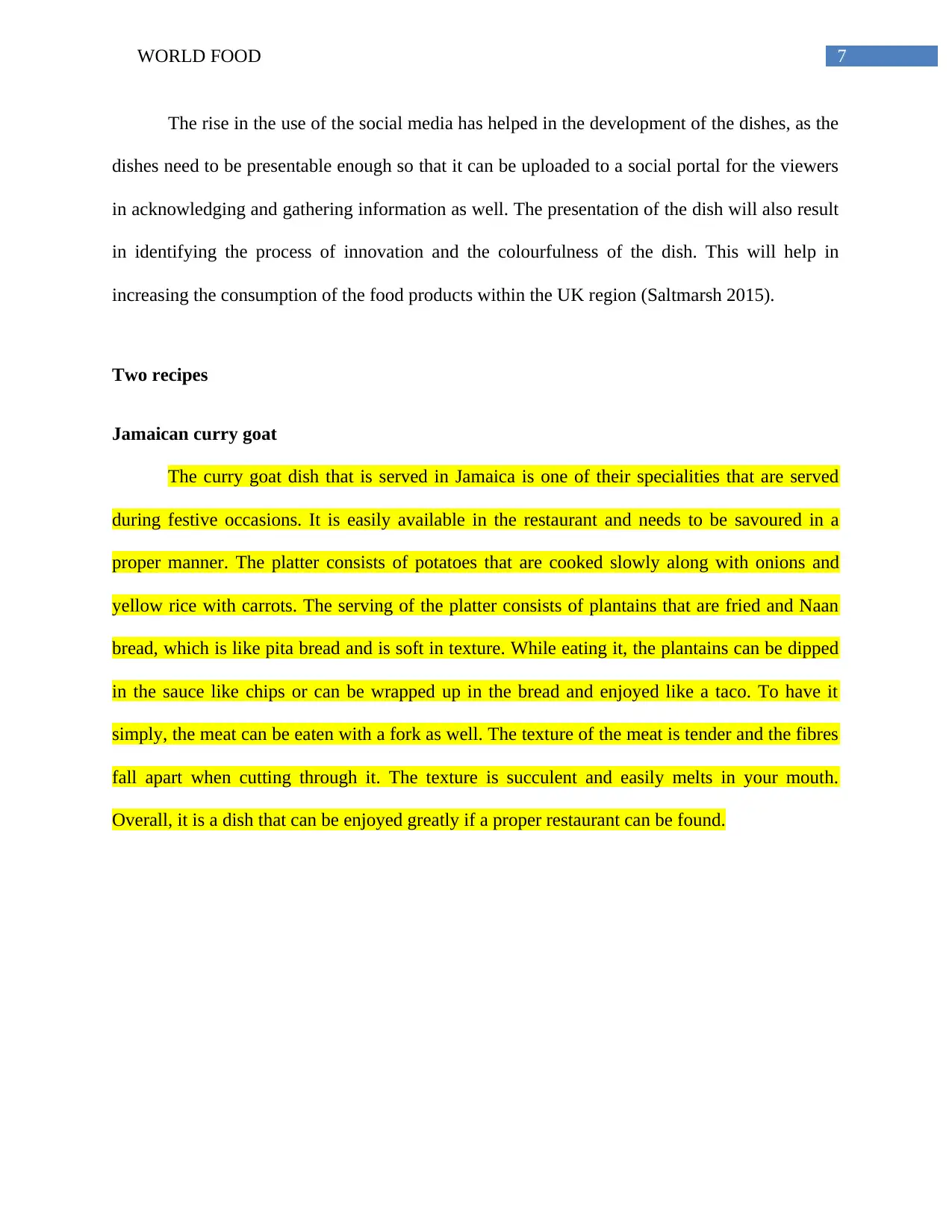
7WORLD FOOD
The rise in the use of the social media has helped in the development of the dishes, as the
dishes need to be presentable enough so that it can be uploaded to a social portal for the viewers
in acknowledging and gathering information as well. The presentation of the dish will also result
in identifying the process of innovation and the colourfulness of the dish. This will help in
increasing the consumption of the food products within the UK region (Saltmarsh 2015).
Two recipes
Jamaican curry goat
The curry goat dish that is served in Jamaica is one of their specialities that are served
during festive occasions. It is easily available in the restaurant and needs to be savoured in a
proper manner. The platter consists of potatoes that are cooked slowly along with onions and
yellow rice with carrots. The serving of the platter consists of plantains that are fried and Naan
bread, which is like pita bread and is soft in texture. While eating it, the plantains can be dipped
in the sauce like chips or can be wrapped up in the bread and enjoyed like a taco. To have it
simply, the meat can be eaten with a fork as well. The texture of the meat is tender and the fibres
fall apart when cutting through it. The texture is succulent and easily melts in your mouth.
Overall, it is a dish that can be enjoyed greatly if a proper restaurant can be found.
The rise in the use of the social media has helped in the development of the dishes, as the
dishes need to be presentable enough so that it can be uploaded to a social portal for the viewers
in acknowledging and gathering information as well. The presentation of the dish will also result
in identifying the process of innovation and the colourfulness of the dish. This will help in
increasing the consumption of the food products within the UK region (Saltmarsh 2015).
Two recipes
Jamaican curry goat
The curry goat dish that is served in Jamaica is one of their specialities that are served
during festive occasions. It is easily available in the restaurant and needs to be savoured in a
proper manner. The platter consists of potatoes that are cooked slowly along with onions and
yellow rice with carrots. The serving of the platter consists of plantains that are fried and Naan
bread, which is like pita bread and is soft in texture. While eating it, the plantains can be dipped
in the sauce like chips or can be wrapped up in the bread and enjoyed like a taco. To have it
simply, the meat can be eaten with a fork as well. The texture of the meat is tender and the fibres
fall apart when cutting through it. The texture is succulent and easily melts in your mouth.
Overall, it is a dish that can be enjoyed greatly if a proper restaurant can be found.
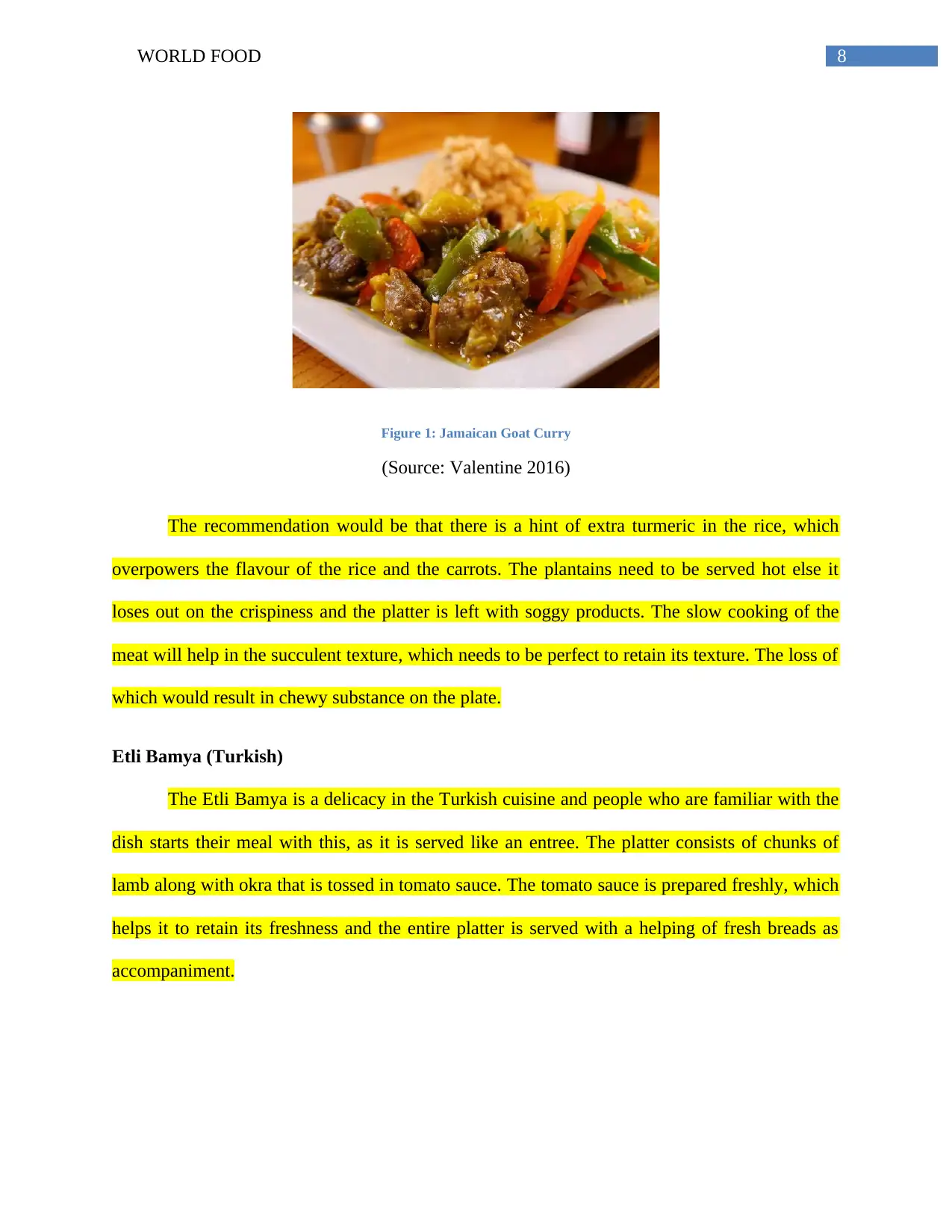
8WORLD FOOD
Figure 1: Jamaican Goat Curry
(Source: Valentine 2016)
The recommendation would be that there is a hint of extra turmeric in the rice, which
overpowers the flavour of the rice and the carrots. The plantains need to be served hot else it
loses out on the crispiness and the platter is left with soggy products. The slow cooking of the
meat will help in the succulent texture, which needs to be perfect to retain its texture. The loss of
which would result in chewy substance on the plate.
Etli Bamya (Turkish)
The Etli Bamya is a delicacy in the Turkish cuisine and people who are familiar with the
dish starts their meal with this, as it is served like an entree. The platter consists of chunks of
lamb along with okra that is tossed in tomato sauce. The tomato sauce is prepared freshly, which
helps it to retain its freshness and the entire platter is served with a helping of fresh breads as
accompaniment.
Figure 1: Jamaican Goat Curry
(Source: Valentine 2016)
The recommendation would be that there is a hint of extra turmeric in the rice, which
overpowers the flavour of the rice and the carrots. The plantains need to be served hot else it
loses out on the crispiness and the platter is left with soggy products. The slow cooking of the
meat will help in the succulent texture, which needs to be perfect to retain its texture. The loss of
which would result in chewy substance on the plate.
Etli Bamya (Turkish)
The Etli Bamya is a delicacy in the Turkish cuisine and people who are familiar with the
dish starts their meal with this, as it is served like an entree. The platter consists of chunks of
lamb along with okra that is tossed in tomato sauce. The tomato sauce is prepared freshly, which
helps it to retain its freshness and the entire platter is served with a helping of fresh breads as
accompaniment.
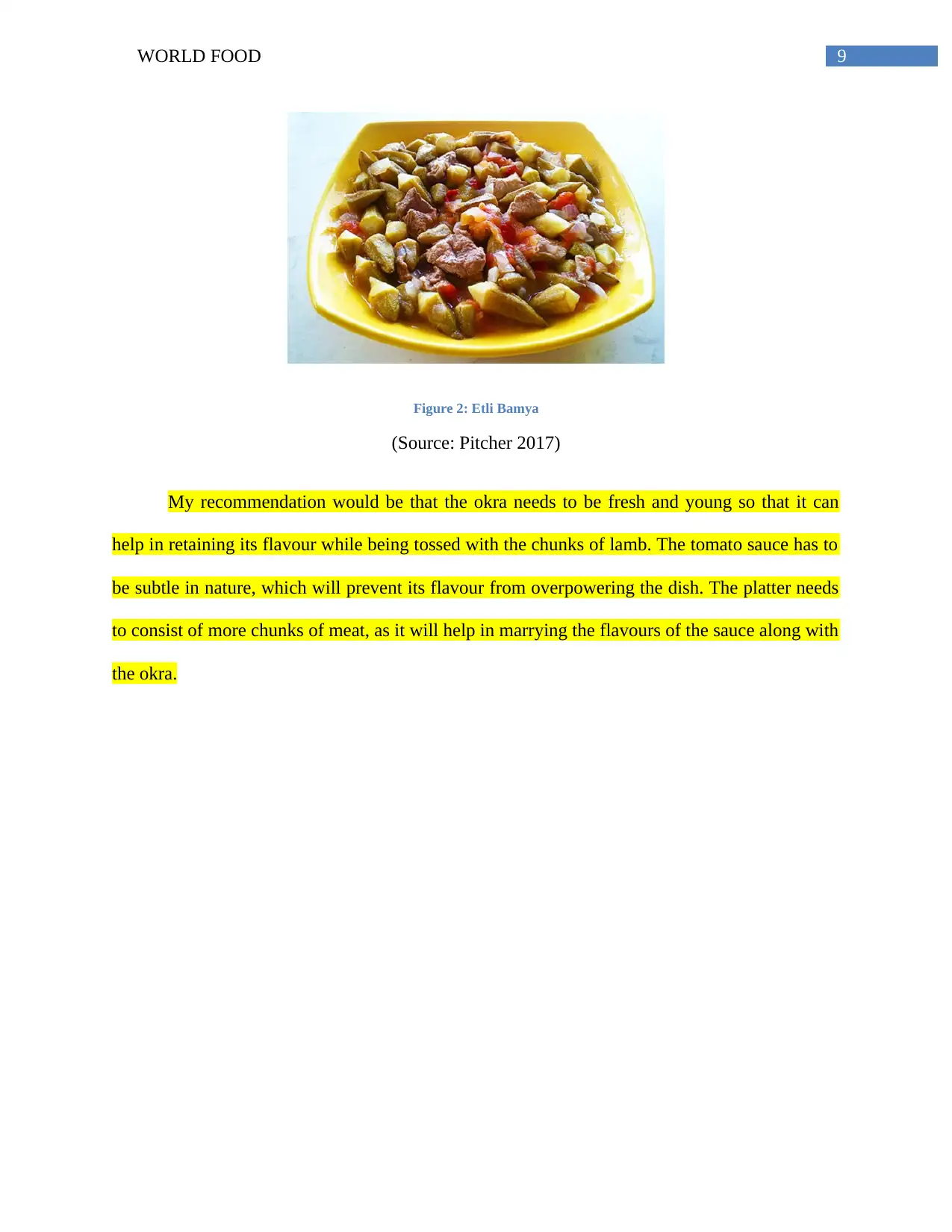
9WORLD FOOD
Figure 2: Etli Bamya
(Source: Pitcher 2017)
My recommendation would be that the okra needs to be fresh and young so that it can
help in retaining its flavour while being tossed with the chunks of lamb. The tomato sauce has to
be subtle in nature, which will prevent its flavour from overpowering the dish. The platter needs
to consist of more chunks of meat, as it will help in marrying the flavours of the sauce along with
the okra.
Figure 2: Etli Bamya
(Source: Pitcher 2017)
My recommendation would be that the okra needs to be fresh and young so that it can
help in retaining its flavour while being tossed with the chunks of lamb. The tomato sauce has to
be subtle in nature, which will prevent its flavour from overpowering the dish. The platter needs
to consist of more chunks of meat, as it will help in marrying the flavours of the sauce along with
the okra.
Secure Best Marks with AI Grader
Need help grading? Try our AI Grader for instant feedback on your assignments.

10WORLD FOOD
Reference List
Ashurst, P.R., 2016. Chemistry and technology of soft drinks and fruit juices. John Wiley &
Sons.
Bigliardi, B. and Galati, F., 2013. Innovation trends in the food industry: the case of functional
foods. Trends in Food Science & Technology, 31(2), pp.118-129.
Claflin, K.W. and Scholliers, P. eds., 2013. Writing food history: a global perspective. Berg.
Danson, M., Galloway, L., Cabras, I. and Beatty, T., 2015. Microbrewing and entrepreneurship:
The origins, development and integration of real ale breweries in the UK. The International
Journal of Entrepreneurship and Innovation, 16(2), pp.135-144.
Davidson, A., 2014. The Oxford companion to food. OUP Oxford.
Dogan, Y., Nedelcheva, A. and Pieroni, A., 2017. The diversity of plants used for the traditional
dish sarma in Turkey: nature, garden and traditional cuisine in the modern era. Emirates Journal
of Food and Agriculture, 29(6), p.429.
Eitzinger, A., Rhiney, K., Farrell, A., Carmona, S., van Loosen, I. and Taylor, M., 2015.
Jamaica: Assessing the impact of climate change on cocoa and tomato.
Ferguson, G.M. and Iturbide, M.I., 2015. Family, food, and culture: Mothers’ perspectives on
Americanization in Jamaica. Caribbean Journal of Psychology, 7(1), pp.43-63.
Guler, O., 2016. What is Your Favorite Local Food Menu? Application of Conjoint Analysis on
The Eastern Mediterranean Cuisine of Turkey. Journal of Tourism and Gastronomy
Studies, 4(3), pp.38-52.
Reference List
Ashurst, P.R., 2016. Chemistry and technology of soft drinks and fruit juices. John Wiley &
Sons.
Bigliardi, B. and Galati, F., 2013. Innovation trends in the food industry: the case of functional
foods. Trends in Food Science & Technology, 31(2), pp.118-129.
Claflin, K.W. and Scholliers, P. eds., 2013. Writing food history: a global perspective. Berg.
Danson, M., Galloway, L., Cabras, I. and Beatty, T., 2015. Microbrewing and entrepreneurship:
The origins, development and integration of real ale breweries in the UK. The International
Journal of Entrepreneurship and Innovation, 16(2), pp.135-144.
Davidson, A., 2014. The Oxford companion to food. OUP Oxford.
Dogan, Y., Nedelcheva, A. and Pieroni, A., 2017. The diversity of plants used for the traditional
dish sarma in Turkey: nature, garden and traditional cuisine in the modern era. Emirates Journal
of Food and Agriculture, 29(6), p.429.
Eitzinger, A., Rhiney, K., Farrell, A., Carmona, S., van Loosen, I. and Taylor, M., 2015.
Jamaica: Assessing the impact of climate change on cocoa and tomato.
Ferguson, G.M. and Iturbide, M.I., 2015. Family, food, and culture: Mothers’ perspectives on
Americanization in Jamaica. Caribbean Journal of Psychology, 7(1), pp.43-63.
Guler, O., 2016. What is Your Favorite Local Food Menu? Application of Conjoint Analysis on
The Eastern Mediterranean Cuisine of Turkey. Journal of Tourism and Gastronomy
Studies, 4(3), pp.38-52.
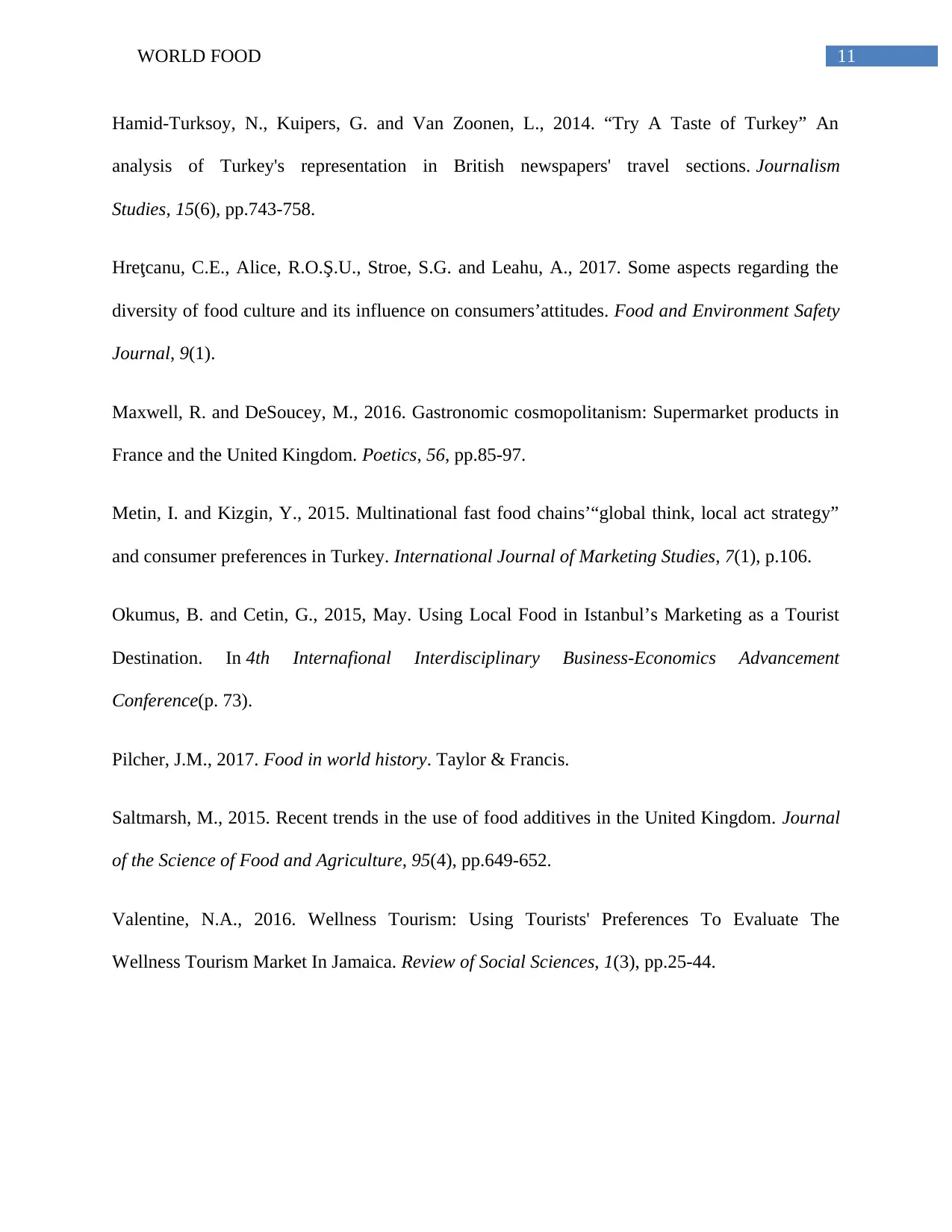
11WORLD FOOD
Hamid-Turksoy, N., Kuipers, G. and Van Zoonen, L., 2014. “Try A Taste of Turkey” An
analysis of Turkey's representation in British newspapers' travel sections. Journalism
Studies, 15(6), pp.743-758.
Hreţcanu, C.E., Alice, R.O.Ş.U., Stroe, S.G. and Leahu, A., 2017. Some aspects regarding the
diversity of food culture and its influence on consumers’attitudes. Food and Environment Safety
Journal, 9(1).
Maxwell, R. and DeSoucey, M., 2016. Gastronomic cosmopolitanism: Supermarket products in
France and the United Kingdom. Poetics, 56, pp.85-97.
Metin, I. and Kizgin, Y., 2015. Multinational fast food chains’“global think, local act strategy”
and consumer preferences in Turkey. International Journal of Marketing Studies, 7(1), p.106.
Okumus, B. and Cetin, G., 2015, May. Using Local Food in Istanbul’s Marketing as a Tourist
Destination. In 4th Internafional Interdisciplinary Business-Economics Advancement
Conference(p. 73).
Pilcher, J.M., 2017. Food in world history. Taylor & Francis.
Saltmarsh, M., 2015. Recent trends in the use of food additives in the United Kingdom. Journal
of the Science of Food and Agriculture, 95(4), pp.649-652.
Valentine, N.A., 2016. Wellness Tourism: Using Tourists' Preferences To Evaluate The
Wellness Tourism Market In Jamaica. Review of Social Sciences, 1(3), pp.25-44.
Hamid-Turksoy, N., Kuipers, G. and Van Zoonen, L., 2014. “Try A Taste of Turkey” An
analysis of Turkey's representation in British newspapers' travel sections. Journalism
Studies, 15(6), pp.743-758.
Hreţcanu, C.E., Alice, R.O.Ş.U., Stroe, S.G. and Leahu, A., 2017. Some aspects regarding the
diversity of food culture and its influence on consumers’attitudes. Food and Environment Safety
Journal, 9(1).
Maxwell, R. and DeSoucey, M., 2016. Gastronomic cosmopolitanism: Supermarket products in
France and the United Kingdom. Poetics, 56, pp.85-97.
Metin, I. and Kizgin, Y., 2015. Multinational fast food chains’“global think, local act strategy”
and consumer preferences in Turkey. International Journal of Marketing Studies, 7(1), p.106.
Okumus, B. and Cetin, G., 2015, May. Using Local Food in Istanbul’s Marketing as a Tourist
Destination. In 4th Internafional Interdisciplinary Business-Economics Advancement
Conference(p. 73).
Pilcher, J.M., 2017. Food in world history. Taylor & Francis.
Saltmarsh, M., 2015. Recent trends in the use of food additives in the United Kingdom. Journal
of the Science of Food and Agriculture, 95(4), pp.649-652.
Valentine, N.A., 2016. Wellness Tourism: Using Tourists' Preferences To Evaluate The
Wellness Tourism Market In Jamaica. Review of Social Sciences, 1(3), pp.25-44.
1 out of 12
Related Documents
Your All-in-One AI-Powered Toolkit for Academic Success.
+13062052269
info@desklib.com
Available 24*7 on WhatsApp / Email
![[object Object]](/_next/static/media/star-bottom.7253800d.svg)
Unlock your academic potential
© 2024 | Zucol Services PVT LTD | All rights reserved.




